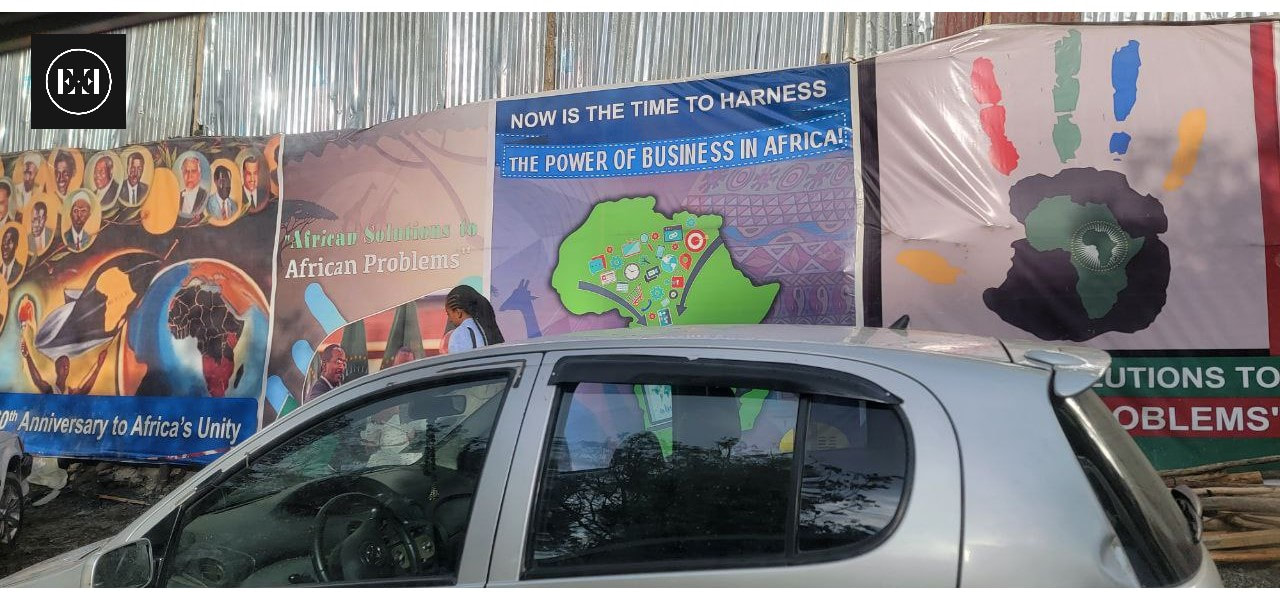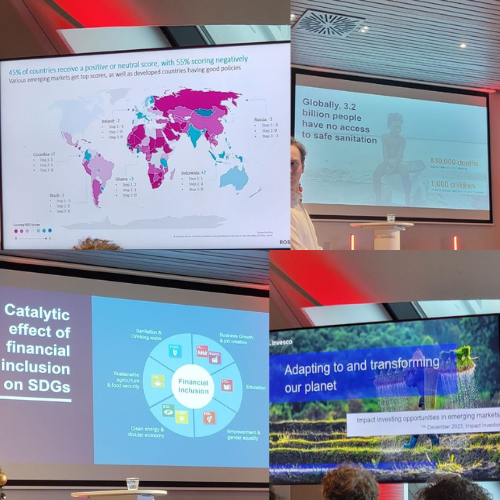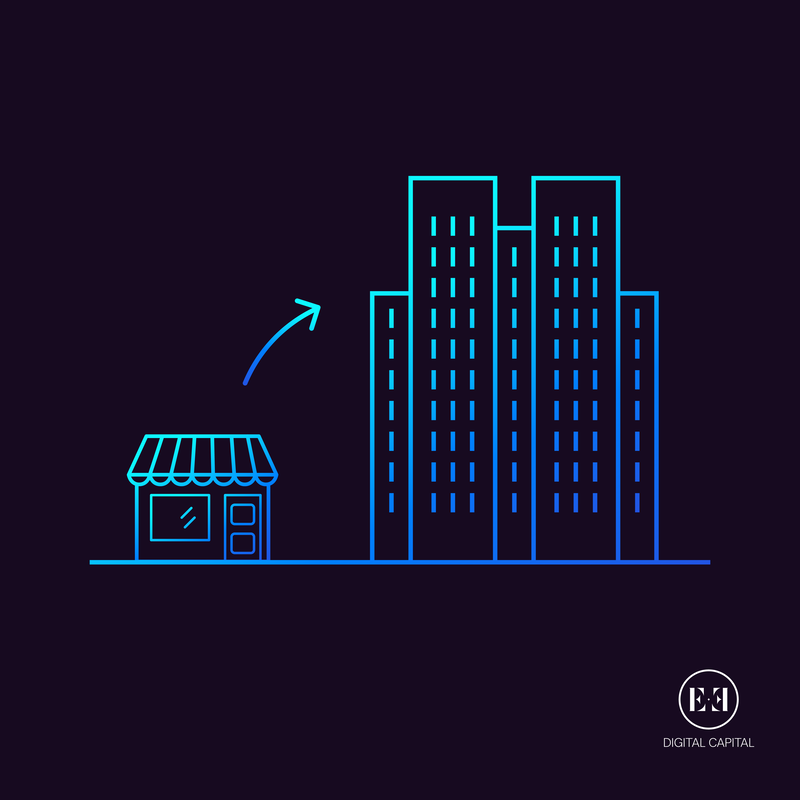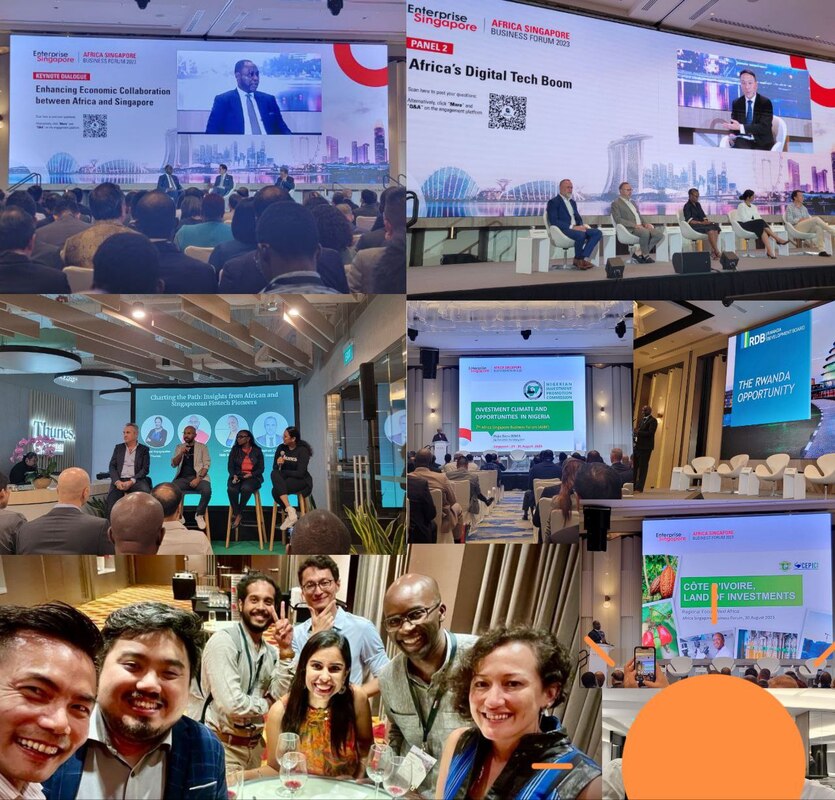|
🌍 Exciting News! 🌍 We're thrilled to host this thoughtful webinar on cross market opportunities between Africa, the Middle East, and Ireland! Have you ever thought about doing business across the different EMEA geographies? Or simply learn about the latest developments in markets such as Saudi Arabia, South Africa, and Nigeria? Come join us on the 19th of July, Friday, at 12pm Dublin/London/Lagos time for an hour of great conversation and networking! --Please share this with your network and anyone else who might be keen-- Our panel discussing the topic include: Eimear Costigan: Senior Market Adviser (Technology), Sub-Saharan Africa - Enterprise Ireland Emeka Chukwureh: Head Customer Flexibility Solutions - ENOWA, NEOM Akinwande Akinsulire: Head of Startup Support - Co-creation Hub (CcHUB) Cikay Richards: CEO of Lyra in Africa And will be moderated by: Leyla F Karaha: Techstars Community Leader and Founder of YourY Network | Social Entrepreneurs Edward Emmanuel: Founder of EE Digital Capital We look forward to seeing you on the 19th! -- Register to attend at https://lu.ma/otuobyoy -- 𝐈𝐟 𝐲𝐨𝐮'𝐯𝐞 𝐞𝐧𝐣𝐨𝐲𝐞𝐝 𝐭𝐡𝐢𝐬 𝐩𝐢𝐞𝐜𝐞 𝐨𝐟 𝐜𝐨𝐧𝐭𝐞𝐧𝐭, 𝐥𝐞𝐚𝐯𝐞 𝐮𝐬 𝐚 𝐜𝐨𝐦𝐦𝐞𝐧𝐭, 𝐬𝐡𝐚𝐫𝐞 𝐭𝐡𝐢𝐬 𝐩𝐢𝐞𝐜𝐞, 𝐨𝐫 𝐬𝐮𝐛𝐬𝐜𝐫𝐢𝐛𝐞 𝐭𝐨 𝐨𝐮𝐫 𝐑𝐒𝐒 𝐟𝐞𝐞𝐝!
𝐏𝐥𝐞𝐚𝐬𝐞 𝐠𝐢𝐯𝐞 𝐮𝐬 𝐚 𝐟𝐨𝐥𝐥𝐨𝐰 𝐨𝐧 𝐬𝐨𝐜𝐢𝐚𝐥 𝐦𝐞𝐝𝐢𝐚 @ 𝐄𝐄 𝐃𝐢𝐠𝐢𝐭𝐚𝐥 𝐂𝐚𝐩𝐢𝐭𝐚𝐥
0 Comments
Last week's download on environmental and social impact was well worth the 5 back-to-back days! We covered everything from the latest regulatory and strategic opportunities in ESG, global benchmarks (Hello EU), regional developments, as well as compliance requirements and trends that could set up organisations / governments over 5, 10, 20 and 30 year timelines and beyond! The stand out highlights include opportunities around climate scenario analyses to carve out strategic ambitions, leveraging green bonds, loans, and sustainability linked notes for favourable finance, as well as Impact Asset Management in Africa and South East Asia! A big thank you to the workshop trainers and a special shout out to the awesome peer discussions we had throughout. More joining up the dots and positive change to come! 𝐈𝐟 𝐲𝐨𝐮'𝐯𝐞 𝐞𝐧𝐣𝐨𝐲𝐞𝐝 𝐭𝐡𝐢𝐬 𝐩𝐢𝐞𝐜𝐞 𝐨𝐟 𝐜𝐨𝐧𝐭𝐞𝐧𝐭, 𝐥𝐞𝐚𝐯𝐞 𝐮𝐬 𝐚 𝐜𝐨𝐦𝐦𝐞𝐧𝐭, 𝐬𝐡𝐚𝐫𝐞 𝐭𝐡𝐢𝐬 𝐩𝐢𝐞𝐜𝐞, 𝐨𝐫 𝐬𝐮𝐛𝐬𝐜𝐫𝐢𝐛𝐞 𝐭𝐨 𝐨𝐮𝐫 𝐑𝐒𝐒 𝐟𝐞𝐞𝐝!
𝐏𝐥𝐞𝐚𝐬𝐞 𝐠𝐢𝐯𝐞 𝐮𝐬 𝐚 𝐟𝐨𝐥𝐥𝐨𝐰 𝐨𝐧 𝐬𝐨𝐜𝐢𝐚𝐥 𝐦𝐞𝐝𝐢𝐚 @ 𝐄𝐄 𝐃𝐢𝐠𝐢𝐭𝐚𝐥 𝐂𝐚𝐩𝐢𝐭𝐚𝐥 Happy Earth Day 2024! 🌍 The coming years are critical in setting the tone for the future of our planet. We've got some ambitious targets to meet by the end of the decade, leading up to our make or break 2050 milestone. At the same time, some exciting opportunities lie at the precipice. Such as fully harnessing market forces to enable our global carbon sinks. Supercharging new forms of sustainable energy in solar, wind, hydrogen, and others. Eliminating our reliance on single use plastic, and plenty more. Let's take a moment to think about how we, in our individual and organisational capacities, can further contribute to the cause. And what better way than to start on this very day! 𝐈𝐟 𝐲𝐨𝐮'𝐯𝐞 𝐞𝐧𝐣𝐨𝐲𝐞𝐝 𝐭𝐡𝐢𝐬 𝐩𝐢𝐞𝐜𝐞 𝐨𝐟 𝐜𝐨𝐧𝐭𝐞𝐧𝐭, 𝐥𝐞𝐚𝐯𝐞 𝐮𝐬 𝐚 𝐜𝐨𝐦𝐦𝐞𝐧𝐭, 𝐬𝐡𝐚𝐫𝐞 𝐭𝐡𝐢𝐬 𝐩𝐢𝐞𝐜𝐞, 𝐨𝐫 𝐬𝐮𝐛𝐬𝐜𝐫𝐢𝐛𝐞 𝐭𝐨 𝐨𝐮𝐫 𝐑𝐒𝐒 𝐟𝐞𝐞𝐝!
𝐏𝐥𝐞𝐚𝐬𝐞 𝐠𝐢𝐯𝐞 𝐮𝐬 𝐚 𝐟𝐨𝐥𝐥𝐨𝐰 𝐨𝐧 𝐬𝐨𝐜𝐢𝐚𝐥 𝐦𝐞𝐝𝐢𝐚 @ 𝐄𝐄 𝐃𝐢𝐠𝐢𝐭𝐚𝐥 𝐂𝐚𝐩𝐢𝐭𝐚𝐥 Despite robust economic growth, Africa🌍 is grappling with a significant issue: its prosperity isn't being evenly distributed 💰👪🏾 Financial inclusion, which is the ability to access and utilise formal financial services effectively, can be a key enabler to this! According to the latest World Bank Development Economics Data, Sub-Saharan Africa has 33% of adults owning mobile money accounts, compared to 10% globally, but only 55% of adults in the region have any form of non-cash remittance financial access. Though this rose by 12% in the past six years, nearly half the adult population (45%) still lacks access to any essential financial services. This is below the 71% average for other developing regions 💱 The gender gap is particularly striking.. Only 49% of women have access to financial services compared to 61% of men. This disparity is often due to limited access to mobile phones and identification documents, which are crucial for setting up and using financial accounts 📱👩🏾💼 When it comes to savings, the data reveals more 😲 39% of mobile money users actively save using their accounts, but overall saving rates in the region is only 56%. Meaning a whopping 44% lack access to any sort of savings instrument. Moreover, only 14% of adults can access $50 in emergency funds in 30 days should their main income source get disrupted! But it's not all bleak. The rapid adoption of digital wallets and mobile money offers a promising pathway for broader financial inclusion. With easier and cheaper access to smartphone data plans, digital wallets are becoming a mainstream solution for financial transactions - think direct peer to peer exchange + micro savings/loans etc. The expansion of digital wallets, as seen with M-Pesa in Kenya, demonstrates the transformative impact these tools can have. By 2025, digital wallets in Africa are expected to generate $15 billion in revenue, growing at a compound annual growth rate of 24% 📈 🚀 But addressing underlying barriers such as the gender gap, digital literacy, enabling affordable data plans, and connecting existing eco-systems and stakeholders on the ground - is a must! Drawing lessons from other developing regions, Brazil's experience with its Pix (Banco Central do Brasil) payment system helped increase financial account ownership from 56% in 2011 to 84% today. Developing an inclusive digital finance ecosystem, fostering a pro-competition environment, and deepening collaboration between incumbent financial institutions and fintech startups are crucial from our Latin American and Asian examples 🇧🇷 🌎 With inclusive financial practices, we can empower individuals and businesses across Africa to participate fully in their economic upside and drive sustainable resilient growth. Are you involved in the space and trying to make a difference? Give us your take on financial inclusion and Africa's rise! 𝐈𝐟 𝐲𝐨𝐮'𝐯𝐞 𝐞𝐧𝐣𝐨𝐲𝐞𝐝 𝐭𝐡𝐢𝐬 𝐩𝐢𝐞𝐜𝐞 𝐨𝐟 𝐜𝐨𝐧𝐭𝐞𝐧𝐭, 𝐥𝐞𝐚𝐯𝐞 𝐮𝐬 𝐚 𝐜𝐨𝐦𝐦𝐞𝐧𝐭, 𝐬𝐡𝐚𝐫𝐞 𝐭𝐡𝐢𝐬 𝐩𝐢𝐞𝐜𝐞, 𝐨𝐫 𝐬𝐮𝐛𝐬𝐜𝐫𝐢𝐛𝐞 𝐭𝐨 𝐨𝐮𝐫 𝐑𝐒𝐒 𝐟𝐞𝐞𝐝!
𝐏𝐥𝐞𝐚𝐬𝐞 𝐠𝐢𝐯𝐞 𝐮𝐬 𝐚 𝐟𝐨𝐥𝐥𝐨𝐰 𝐨𝐧 𝐬𝐨𝐜𝐢𝐚𝐥 𝐦𝐞𝐝𝐢𝐚 @ 𝐄𝐄 𝐃𝐢𝐠𝐢𝐭𝐚𝐥 𝐂𝐚𝐩𝐢𝐭𝐚𝐥 "Murakaza Neza!" or "Welcome!" in Kinyarwanda, introduces Rwanda 🇷🇼 , a country of breathtaking hills, landscapes and a vibrant populace of just over 13 million. As of 2023, this nation boasts a flourishing 50 billion dollar economy, rapidly positioning itself as one of Africa's premier investment hotspots 🌍. This surge in interest is no accident; Rwanda's forward-thinking policies and welcoming business climate, encapsulated in the initiative "Doing Business in Rwanda," are key drivers of its allure. Why Set Your Sights on Rwanda? It’s almost a breeze for entrepreneurs. Initiating a venture in Rwanda is refreshingly simple. The nation stands out on the World Bank's Ease of Doing Business Index (2022), ranking 38th globally and second in Africa—a testament to its streamlined entrepreneurial landscape 💼 Incentives Galore! Rwanda rolls out the red carpet for investors with perks designed to ease business operations right from the start. Highlights include a two-year trade licence waiver for new SMEs, complimentary business registration, and an efficient six-hour online registration process. Add to that a one-stop centre for investor support, no foreign ownership or capital flow restrictions, and capital gains tax exemptions, and you've got an irresistible package 💰 There’s robust Infrastructure incoming and wild tech ambitions. Rwanda prides itself on its dynamic private sector, ambitious infrastructure projects, and industrial parks that nurture commerce. Moreover, the nation is on a mission to cement its status as Africa's tech nucleus, with initiatives like the Kigali Innovation City—a $1.9 billion venture poised to be a crucible of ICT excellence🏗️🚀 The Rwandan economy has kaleidoscope of opportunities, with its tentacles spread across education, healthcare, IT, and financial services, presents a fertile ground for diverse investment ventures 📈 More Than Just Profits: Social and Environmental Vision Rwanda's investment appeal transcends financial metrics, offering a chance to be part of a society committed to both social progress and environmental stewardship: Youthful Vigour: With 70% of its population under 30, Rwanda is a hotbed of innovation and entrepreneurship reflective of Africa’s overall demographic dividend. A young population looking to capitalise on the opportunities as a potential hub of East Africa and beyond🌱 Eco-Conscious Development: The Rwandan government's vision for a climate-resilient and carbon-neutral future by 2050 is bold and clear. We can see traces of this no nonsense approach after it became one of the first countries globally to ban single use plastic bags and bottles since 2008! Through pioneering a carbon market framework, Rwanda incentivises sustainable business practices and technology investment, balancing economic expansion with ecological and social harmony. This carbon trading initiative not only motivates businesses to minimise their carbon footprint for financial gain but also aligns with global efforts to combat climate change, setting a commendable example for other nations 🌳♻️ We’re hopeful at EE Digital Capital about the impact policy and direction from the top has in addressing societal and environmental issues. Rwanda serves as a stunning example of how frontier and emerging economies can galvanise the private sector and steward capital into sectors of interest and bastions of opportunity. We’ll continue to watch this space 🌟 𝐈𝐟 𝐲𝐨𝐮'𝐯𝐞 𝐞𝐧𝐣𝐨𝐲𝐞𝐝 𝐭𝐡𝐢𝐬 𝐩𝐢𝐞𝐜𝐞 𝐨𝐟 𝐜𝐨𝐧𝐭𝐞𝐧𝐭, 𝐥𝐞𝐚𝐯𝐞 𝐮𝐬 𝐚 𝐜𝐨𝐦𝐦𝐞𝐧𝐭, 𝐬𝐡𝐚𝐫𝐞 𝐭𝐡𝐢𝐬 𝐩𝐢𝐞𝐜𝐞, 𝐨𝐫 𝐬𝐮𝐛𝐬𝐜𝐫𝐢𝐛𝐞 𝐭𝐨 𝐨𝐮𝐫 𝐑𝐒𝐒 𝐟𝐞𝐞𝐝!
𝐏𝐥𝐞𝐚𝐬𝐞 𝐠𝐢𝐯𝐞 𝐮𝐬 𝐚 𝐟𝐨𝐥𝐥𝐨𝐰 𝐨𝐧 𝐬𝐨𝐜𝐢𝐚𝐥 𝐦𝐞𝐝𝐢𝐚 @ 𝐄𝐄 𝐃𝐢𝐠𝐢𝐭𝐚𝐥 𝐂𝐚𝐩𝐢𝐭𝐚𝐥 Investing and supporting the right companies will play a crucial role in mitigating the impacts of global climate change 🌍 🍀 🌊 The world is grappling with rising sea levels and declining water supplies, which are directly affecting the livelihoods of millions of people across the globe. Africa, despite being responsible for less than 10% of global greenhouse gas emissions, is unfortunately, highly vulnerable to the effects of climate change.. For example, over 110 million people in Africa were directly affected by climate and water-related hazards in 2022, resulting in economic damages of over 8.7 billion EUR. Likewise, the Emergency Event Database reported approximately 5,000 fatalities, with 48 percent attributed to drought and 43 percent to flooding. However, the true toll is likely much higher due to under-reporting. Investing in climate action, and by extension, companies addressing climate change, will be crucial in addressing these repercussions in Africa. Thankfully, investments into the local industry are already picking up! 📈 As of end-December 2022, the African Development Bank had approved 34 projects for which it has deployed 920 million EUR equivalent in CIF resources in addition to 1.99 billion EUR equivalent of its own co-financing deployed into climate change initiatives on the continent. Likewise, venture capital recorded a cool US$800 million deployed into African climate action startups for all of last year! Africa's abundance of renewable energy resources, available land, and young population make it an attractive investment destination for climate action 🌄 The opportunities in the continent are drawing investors who are determined to bring about meaningful change for global climate issues.. Another example of this has come in the form of ‘carbon sinks’ on the continent. According to the United Nations Development Programme (UNDP), carbon markets are trading systems in which carbon credits are sold and bought. Of which, carbon sinks are the physical embodiments that can help accumulate and store carbon, removing it from the atmosphere, and accumulate carbon credits in the process! Africa, with its rich mosaic of natural ecosystems, could potentially build carbon credits into the continent's next significant export 🌿 🍃 And with it, the tech solutions that can enable its fostering, maintenance, and management. All developed and deployed locally 💻 🤓 👧 🛠 In the recent COP28 UN Climate Change Conference in Dubai, more deals were announced as part of the Africa Carbon Markets Initiative (ACMI), with an aim to raise US$6 billion by 2030. At EE Digital Capital, we’re at the forefront of these opportunities, seeing first hand how the right levers of capital can make lasting changes on the ground. And Africa’s role in our global pursuit of sustainability, though yet fully realised, is definitely on its way 🚂 🚂 #africa #tech #climatechange 𝐈𝐟 𝐲𝐨𝐮'𝐯𝐞 𝐞𝐧𝐣𝐨𝐲𝐞𝐝 𝐭𝐡𝐢𝐬 𝐩𝐢𝐞𝐜𝐞 𝐨𝐟 𝐜𝐨𝐧𝐭𝐞𝐧𝐭, 𝐥𝐞𝐚𝐯𝐞 𝐮𝐬 𝐚 𝐜𝐨𝐦𝐦𝐞𝐧𝐭, 𝐬𝐡𝐚𝐫𝐞 𝐭𝐡𝐢𝐬 𝐩𝐢𝐞𝐜𝐞, 𝐨𝐫 𝐬𝐮𝐛𝐬𝐜𝐫𝐢𝐛𝐞 𝐭𝐨 𝐨𝐮𝐫 𝐑𝐒𝐒 𝐟𝐞𝐞𝐝!
𝐏𝐥𝐞𝐚𝐬𝐞 𝐠𝐢𝐯𝐞 𝐮𝐬 𝐚 𝐟𝐨𝐥𝐥𝐨𝐰 𝐨𝐧 𝐬𝐨𝐜𝐢𝐚𝐥 𝐦𝐞𝐝𝐢𝐚 @ 𝐄𝐄 𝐃𝐢𝐠𝐢𝐭𝐚𝐥 𝐂𝐚𝐩𝐢𝐭𝐚𝐥 An insightful day of presentations and connections at this year's Impact Investor Conference! Connecting the dots on capital allocation into impact causes of people and planet, a reported USD 1 trillion was deployed in the preceding year. A record number! But the challenges have increased too.. Another note was how there was a disproportionate amount of capital that flowed into global north deals, compared to the global south and Least-Developed Countries (LDC). Interestingly, investment managers are now looking at different ways to categorise risk and opportunities in the global south, where asset manager Robeco came up with a '3-Step' scoring system that helped highlight the likes of Ghana and Indonesia among countries that scored well for emerging economy investment destinations. Sadly, Ireland got marked down in scoring for their apparent fuel subsidies! More work to be done (: Thanks to the organisers at FD Business/FD Mediagroup and all the other folks we connected with! 𝐈𝐟 𝐲𝐨𝐮'𝐯𝐞 𝐞𝐧𝐣𝐨𝐲𝐞𝐝 𝐭𝐡𝐢𝐬 𝐩𝐢𝐞𝐜𝐞 𝐨𝐟 𝐜𝐨𝐧𝐭𝐞𝐧𝐭, 𝐥𝐞𝐚𝐯𝐞 𝐮𝐬 𝐚 𝐜𝐨𝐦𝐦𝐞𝐧𝐭, 𝐬𝐡𝐚𝐫𝐞 𝐭𝐡𝐢𝐬 𝐩𝐢𝐞𝐜𝐞, 𝐨𝐫 𝐬𝐮𝐛𝐬𝐜𝐫𝐢𝐛𝐞 𝐭𝐨 𝐨𝐮𝐫 𝐑𝐒𝐒 𝐟𝐞𝐞𝐝! 𝐏𝐥𝐞𝐚𝐬𝐞 𝐠𝐢𝐯𝐞 𝐮𝐬 𝐚 𝐟𝐨𝐥𝐥𝐨𝐰 𝐨𝐧 𝐬𝐨𝐜𝐢𝐚𝐥 𝐦𝐞𝐝𝐢𝐚 @ 𝐄𝐄 𝐃𝐢𝐠𝐢𝐭𝐚𝐥 𝐂𝐚𝐩𝐢𝐭𝐚𝐥 The concept of certain cities and countries being springboards | launchpads | and gateways, is nothing new! 🏹🎯 When looking to access new markets, there's always been the need to address the 'beachhead', whether in the form of an initial customer segment, geographic location, or more likely the combination of the two! But what makes a stellar gateway location? Ideally, your gateway location has a tried and tested process to 'fast track' a pilot trial project to prove its capabilities in a real-life operational environment. Secondly, it has the support of an ecosystem and environment that encourages the trialing, testing, and general ethos of innovation when it comes to using new products and services. And you're going to have failures along the way unfortunately. It comes with the package 😅 So the ecosystems that foster acceptance of BOTH wins and losses is critical. Conducive ecosystems and environments also come in the form of smooth administration for business entities, programmes that help accelerate customer interaction and acquisition, access to mentors and talents with the requisite skill sets, as well as access to capital. Last but not least, a network or pathways that will help get businesses off the ground into other geographic markets when the time comes for it. In other words, the export phase! I can already think of two countries that meet the above requirements. 🇮🇪 Ireland as a gateway into Europe. 🇸🇬 Singapore as a gateway into Asia. That's right, this is me not being biased at all 😄 Can you think of anything else that makes a great gateway or launchpad location? What are other regions, countries, or cities that come to mind? And finally, what could be an equivalent for the African continent? 𝐈𝐟 𝐲𝐨𝐮'𝐯𝐞 𝐞𝐧𝐣𝐨𝐲𝐞𝐝 𝐭𝐡𝐢𝐬 𝐩𝐢𝐞𝐜𝐞 𝐨𝐟 𝐜𝐨𝐧𝐭𝐞𝐧𝐭, 𝐥𝐞𝐚𝐯𝐞 𝐮𝐬 𝐚 𝐜𝐨𝐦𝐦𝐞𝐧𝐭, 𝐬𝐡𝐚𝐫𝐞 𝐭𝐡𝐢𝐬 𝐩𝐢𝐞𝐜𝐞, 𝐨𝐫 𝐬𝐮𝐛𝐬𝐜𝐫𝐢𝐛𝐞 𝐭𝐨 𝐨𝐮𝐫 𝐑𝐒𝐒 𝐟𝐞𝐞𝐝! 𝐏𝐥𝐞𝐚𝐬𝐞 𝐠𝐢𝐯𝐞 𝐮𝐬 𝐚 𝐟𝐨𝐥𝐥𝐨𝐰 𝐨𝐧 𝐬𝐨𝐜𝐢𝐚𝐥 𝐦𝐞𝐝𝐢𝐚 @ 𝐄𝐄 𝐃𝐢𝐠𝐢𝐭𝐚𝐥 𝐂𝐚𝐩𝐢𝐭𝐚𝐥 All young companies wish to grow into corporate success machines eventually 🏢⚙️🤓 With it comes a lot more resources to tackle everything from research, product development, communications, and operations. These resources also allow them to specialise. Expertise in each given role, to carry out a particular task to its best ability. What you get is a juggernaut, cogs in a well-oiled machine that keeps the engine humming, and going at speed in the direction of the executive team ⏩⏩⏩ But what corporations struggle with is precisely what start-ups excel at! Operating at the bleeding edge requires deftness, being able to switch direction at a moment's notice, and make decisions at sufficient speed. Traditionally, start ups are known to be nimble, quick, and agile 🐈 😼 Ever-ready to meet the needs of its market and customers. A flatter hierarchy also allows decisions to be made a lot faster! So you're looking to 'get things done', with less layers of management, and interference. But alas, the growing pains stage of a start-up requires specializing, and the days of the generalist founding team gets numbered. Leadership being funneled off into their specific departments to be built up. So if start-ups want to become corporations eventually, what should corporations take away from start-ups? Stay tuned as we explore how large organisations can learn a thing or two from budding young companies, of which ironically, they were fully on top of when just starting out ⛰️ 𝐈𝐟 𝐲𝐨𝐮'𝐯𝐞 𝐞𝐧𝐣𝐨𝐲𝐞𝐝 𝐭𝐡𝐢𝐬 𝐩𝐢𝐞𝐜𝐞 𝐨𝐟 𝐜𝐨𝐧𝐭𝐞𝐧𝐭, 𝐥𝐞𝐚𝐯𝐞 𝐮𝐬 𝐚 𝐜𝐨𝐦𝐦𝐞𝐧𝐭, 𝐬𝐡𝐚𝐫𝐞 𝐭𝐡𝐢𝐬 𝐩𝐢𝐞𝐜𝐞, 𝐨𝐫 𝐬𝐮𝐛𝐬𝐜𝐫𝐢𝐛𝐞 𝐭𝐨 𝐨𝐮𝐫 𝐑𝐒𝐒 𝐟𝐞𝐞𝐝! 𝐏𝐥𝐞𝐚𝐬𝐞 𝐠𝐢𝐯𝐞 𝐮𝐬 𝐚 𝐟𝐨𝐥𝐥𝐨𝐰 𝐨𝐧 𝐬𝐨𝐜𝐢𝐚𝐥 𝐦𝐞𝐝𝐢𝐚 @ 𝐄𝐄 𝐃𝐢𝐠𝐢𝐭𝐚𝐥 𝐂𝐚𝐩𝐢𝐭𝐚𝐥 Click The mission? Further integrate the two most populous continents when it comes to economic upside and riding the waves of expansion! 🌊 The Africa Singapore Business Forum 2023 was a great teaser of what can be 🌍 🇸🇬 When titans in Africa and Asia come together and seek out win-win outcomes, nothing is impossible! A big takeaway was how it was SO important to have local partners provide the required local insight AND representative capital that helps signal to the markets there is indeed grassroots confidence in the opportunities. It's all about confidence building. Whether in emerging or frontier Africa-Asia. And how we circle back to the concepts of gateways. Where Singapore sits as a gateway into South-East Asia and the general Asia-Pacific region. And how this is developing for similar African counterparts. There's a lot more to come when we connect these gateways and nodes directly, and how we're dependent on people themselves to reach out and make these connections ➡️ ⬅️ Are you in the ESG, Impact, or Tech space and resonate with this Africa-Asia collab? Time to connect the people, talent, and capital and see these continents thrive 🌻 𝐈𝐟 𝐲𝐨𝐮'𝐯𝐞 𝐞𝐧𝐣𝐨𝐲𝐞𝐝 𝐭𝐡𝐢𝐬 𝐩𝐢𝐞𝐜𝐞 𝐨𝐟 𝐜𝐨𝐧𝐭𝐞𝐧𝐭, 𝐥𝐞𝐚𝐯𝐞 𝐮𝐬 𝐚 𝐜𝐨𝐦𝐦𝐞𝐧𝐭, 𝐬𝐡𝐚𝐫𝐞 𝐭𝐡𝐢𝐬 𝐩𝐢𝐞𝐜𝐞, 𝐨𝐫 𝐬𝐮𝐛𝐬𝐜𝐫𝐢𝐛𝐞 𝐭𝐨 𝐨𝐮𝐫 𝐑𝐒𝐒 𝐟𝐞𝐞𝐝! 𝐏𝐥𝐞𝐚𝐬𝐞 𝐠𝐢𝐯𝐞 𝐮𝐬 𝐚 𝐟𝐨𝐥𝐥𝐨𝐰 𝐨𝐧 𝐬𝐨𝐜𝐢𝐚𝐥 𝐦𝐞𝐝𝐢𝐚 @ 𝐄𝐄 𝐃𝐢𝐠𝐢𝐭𝐚𝐥 𝐂𝐚𝐩𝐢𝐭𝐚𝐥 |
ArticlesUseful content to navigate the landscapes of innovation and disruption Archives
July 2024
Categories
All
|











 RSS Feed
RSS Feed